SmartBees Newsletter 5, April 2018
SMARTBEES is beginning its last year and we take the opportunity to inform our interested reader on the progress of our work and the highlights of the past months.
Improving resilience of honey bees through nutrition
(Maureen Wakefield, Francesco Nazzi and Francesco Pennacchio)
(Maureen Wakefield, Francesco Nazzi and Francesco Pennacchio)
Introduction
Honey bee (Apis mellifera) health is threatened by multiple factors including pests and diseases. The Varroa mite (Varroa destructor) feeds on bee larvae, resulting in weakened adults with a shorter life span. Varroa destructor also vectors viruses, such as deformed wing virus (DWV), and can trigger their replication in infested bees (Figure 1). For these reasons, if left untreated infected colonies will die within 1-3 years. There has been extensive research and a range of control methods developed to counteract Varroa; however, eradication of this pest is not possible, therefore integrated pest management plans for control have been developed.
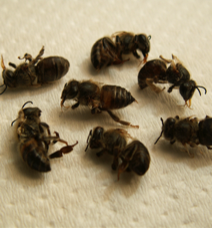
Recently, researchers have started to look at the problem of threats to honey bee health from a different angle. Rather than trying to control or eliminate the multiple threats to honey bee health, is it possible to increase the resilience of the honey bees to pests and diseases? Selection of tolerant bees is a promising strategy to improve the overall resilience of honey bee colonies. Smartbees has been the first pan-European project aiming at achieving that goal while preserving biodiversity. However, selection is a long-term endeavour and the threats to honey bees are acute requiring short to medium term solutions. Therefore, other “ready to use” tools must be found.
Nutrition is one of the many factors affecting honey bee health. Changes in the landscape that negatively affect the availability and quality of nectar and pollen resources impact on the health of individual colonies. Furthermore, we cannot exclude that some of the substrates provided to bees for supplementary nutrition could have still unknown negative effects on bees. Conversely, nutrition could play a very positive role if feed could enhance the tolerance of honey bees towards factors such as parasites, pathogens and pesticides, thereby increasing the resilience of honey bee populations to adverse events.
Honey bees require a source of protein, lipids, carbohydrates, vitamins and minerals, which must also be present in a balanced ratio for optimum nutrition. Specific requirements will change throughout the life cycle. The main nutrients are supplied primarily by nectar (carbohydrates) and pollen (protein and lipids). Although there have been numerous studies on how nutrition affects survival, reproduction and tolerance to biotic and abiotic stresses in honey bees, the impact of nutrition on the ability to combat pests and diseases has received less attention.
To understand whether nutrition can improve the resilience of honey bees, both at an individual and a colony level, a number of questions need to be considered, including:
- What are the nutritional requirements for bees when healthy and diseased?
- Can a particular feed improve the ability of bees to deal with particular stress factors?
- Is common supplementary nutrition completely free of risk to bees?
- Is there anything related to nutrition that beekeepers can do to improve the health of their colonies?
Pollen – an important factor in the response to parasitization
The importance of pollen in the ability of adult bees to cope with parasitization by Varroa has been demonstrated in laboratory tests by researchers at the Università degli Studi di Udine. Healthy bees that had not been exposed to Varroa had similar longevity when fed a sugar diet alone or a sugar diet supplemented with pollen (Figure 2). However, bees that had been exposed to Varroa at the pupal stage showed a significant increase in longevity when fed a sugar solution supplemented with pollen, as compared with bees fed on sugar solution alone (Figure 2). A small-scale field trial using a total of eight colonies, four of which were provided with additional protein, also indicated a positive effect of pollen (Annoscia et al., 2017). However, larger scale trials are needed to demonstrate whether there is a significant effect in the field, which could ultimately be used by beekeepers.
To gain a greater understanding of the mechanism by which pollen could be improving the longevity of bees exposed to Varroa, an analysis was made of the effect of pollen components on individual bees. Different solvents were used to remove either the polar (without lipids) or apolar components (which contains lipids) of the pollen and this pollen was fed to infested bees. The results clearly showed that when the apolar components were removed from the pollen the mortality of infested bees was significantly higher than for bees fed with the complete pollen (Annoscia et al., 2017). A similar, but non-significant effect was also observed when the polar fraction was removed. The results suggest that lipids may have a role in the beneficial effects of pollen observed in the tests (Annosica et al., 2017). The effect of the polar fraction is less clear, but this fraction could still have beneficial effects. Further studies are needed to fully understand the relative importance of the pollen components.
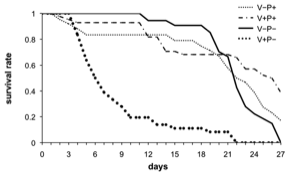
A role for essential amino acids?
At UNINA and Fera, research focussed on the role of essential amino acids in the honey bee diet. Researchers at UNINA examined the effect of increasing amounts of essential amino acids in the diet under a “no choice” condition on adult worker survival and the level of infection of DWV. Newly emerged worker bees in groups of 30 were reared in a plastic box at constant temperature and humidity and allowed to access a feeding tube containing sucrose and essential amino acids (EEAs) at four different concentrations (control, low, medium and high). The number of dead bees in each box was recorded daily for 15 days. Every three days, five live bees were collected and immediately frozen at -80°C to determine the level of DWV in the bees. The results showed that nurse bees exhibited a significantly shorter survival rate when fed with the diet containing the highest level of amino acids. Moreover, the same experimental bees showed a significantly marked increase in the level of DWV. These results clearly indicate that unbalanced nutrition, characterized by an excess of amino acids, enhances bee susceptibility to viral pathogens and is associated with higher mortality. This result corroborates the occurrence of strong cross-modulatory pathways between nutrition and immunity.
Researchers at Fera examined the effect of supplementation of honey bee diet with essential amino acids on the ability of adult worker bees to suppress amplification of deformed wing virus (DWV) in laboratory bioassays. Worker bees were collected from frames within 24 hr of emergence and put into groups each containing 15 adult workers. The groups were maintained in cages (Figure 3) and supplied with either a sucrose solution or sucrose solution containing EAA for 72 h. Subsequently, groups of bees in each feeding treatment were injected with purified DWV or ringer solution, with non-injected individuals serving as an additional control. Following injection, the feeders were replenished with either sucrose solution or sucrose/EAA solution and worker bees maintained for a further 72 hr. Workers were then frozen and the DWV level in individual bees was determined.
Injection of ringer solution did not result in an increase in the viral load compared with non-injected bees. Supplementation of sucrose solution with essential amino acids did not have any significant effect on the amplification of the virus in adult worker bees injected with DWV. Therefore, under the conditions of the test, the presence of essential amino acids did not boost the ability of adult worker bees to suppress levels of DWV.
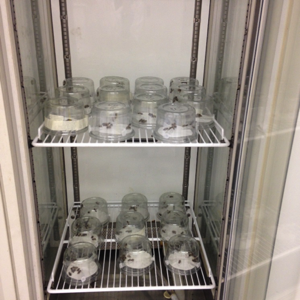
Conclusion
Within the Smartbees project we have demonstrated that nutrition has an important role in the ability of honey bees to mitigate the effects of parasites and pathogens. Further research will investigate the mechanisms involved in these responses to gain a better understanding of the links between nutrition and immunity. If the promising laboratory results can be validated in the field it may be possible to make recommendations to beekeepers for nutritional supplements that could improve the resilience of colonies to pests and diseases.
Reference
Annoscia, D., Zanni, V., Galbraith, D., Quirici, A., Grozinger, C., Bortolomeazzi, R and Nazzi, F (2017). Elucidating the mechanisms underlying the beneficial health effects of dietary pollen on honey bees (Apis mellifera) infested by Varroa mite ectoparasites. Scientific Reports 7:6258 DOI:10.1038/s41598-017-06488-2
Conservation of the endemic Maltese honey bee (Apis mellifera ruttneri)
Dr Aleksandar Uzunov, Dr Marina Meixner, Dr Ralph Büchler, Thomas Galea
Dr Aleksandar Uzunov, Dr Marina Meixner, Dr Ralph Büchler, Thomas Galea
Apis mellifera ruttneri is the endemic honey bee of Malta where more than 4000 colonies are managed on the main islands of Malta, Gozo and Comino. It is believed that beekeeping has been practiced in Malta since the Punic times. Ancient Roman apiaries dating over 2000 years are a living evidence of such practices which are well preserved to this day serving as local tourist attractions.
Besides the beekeeping tradition the black endemic honey bee, nowadays recognized as separate subspecies A. m. ruttneri - named after Friedrich Ruttner - has attracted a lot of public and scientific attention. Due to the regular importation of foreign stock and the presence of commercial queen producing operations propagating Italian, Carniolan and Buckfast stock, the native population is becoming hybridized and critically endangered. This led to a joint effort between a group of enthusiastic Maltese breeders and SMARTBEES consortium to work on the conservation of A. m. ruttneri.
Characterizing A. m. ruttneri
A collaborative research project from the University of Malta and the Bee Institute Kirchhain, Germany, examined the status of the Maltese honey bee population using morphometric and mitochondrial DNA analyses. It was found that – in spite of all previous and ongoing importations of foreign stocks – unhybridized colonies displaying the characteristic morphology and mtDNA features of A. m. ruttneri still exist on the archipelago and can be used as the basis for a conservation program (JAR 2017, 56(5), 514-522). In addition, an extensive sampling of the Maltese population has been carried out as part of the ongoing Apis mellifera subspecies identification based on next generation sequencing in SMARTBEES WP3.
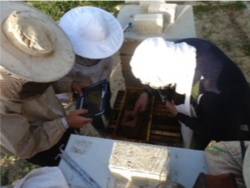
The SMARTBEES strategy of “Conservation by utilisation” implies enhancement of the attractiveness of the local honey bee population by improvement of performance and behaviour. By breeding attractive bees, the local beekeeping community will lose interest to purchase queens and swarms originating from non-local populations. As in many other regions in Europe, the first steps in Malta were done towards the enhancement of beekeepers’ understanding of breeding, in particular performance testing, data collection, interpretation of the results and selection of the best performers. Thus, since early 2016 several theoretical and on-field training sessions were organized for the Maltese beekeepers who showed great interest and motivation (Figure 1 - right: Training of Maltese beekeepers).
The testing activities were initiated in 2016 and 2017 when groups of sister queens were exchanged among several testing apiaries. Due to lack of experience in breeding, queen rearing and exchange the local breeding group experienced some failures to set up testing apiaries and collect data. However, there were improvements on the 2nd attempt of apiary set-ups and now the breeding group is dedicated to successfully run the testing and collect data for the estimation of the first ever breeding values for A. m. ruttneri. Currently, there are seven testing apiaries with more than 60 colonies headed by queens from seven different sister groups.
Due to the limited land area and the high colony density in Malta, the introduction of mating control is a challenge. That is why in April 2017 experiments were performed to assess the suitability of the small island of Comino as a mating station (Figure 2). The results indicate that using proper beekeeping practices to maintain drone colonies together with the local beekeepers being involved, Comino could be a prospective mating station. In addition, a representative of the breeding group in Malta was trained for use of instrumental insemination, which may seem a feasible solution on the way to control the mating of selected A. m. ruttneri (Figure 3).
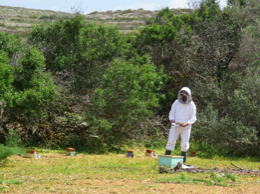
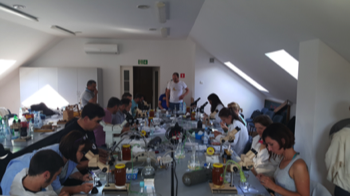
Figure 2. Observation of mating boxes on Comino.
Figure 3. SMARTBEES training for instrumental insemination, Pulawy, Poland.
Studying the Maltese honey bee
Breeding always goes “hand in hand” with the enhancement of knowledge and understanding of the honey bee biology. In that sense, in addition to the data generated by testing and breeding, a comparative study was started in 2017 in close collaboration with the colleagues from the University of Malta. Thirty-three colonies, headed by sister queens of the native A. m. ruttneri and the introduced commercial A. m. ligustica, are compared concerning the main traits of interest including colony development, honey production, gentleness, swarming and disease related parameters. The study will elucidate the differences between the local bee and the most popular introduced non-native bee under Maltese conditions and will provide additional insights on the interactions between each genotype and the environment.
Raising the awareness
The conservation of honey bee populations, in particular under peculiar conditions in Malta, is a complex task. Breeding and research activities are fundamentally important, but there are other aspects that could support and even accelerate the process. In the last two years a series of actions support the raising issue on academic, public and political levels. In addition to the regular meetings and training with the engaged breeders, several popular articles reporting the progress achieved in Malta have been published. Meetings were held with representatives of the Maltese government as well as with the President of the country, HE Marie-Louise Coleiro Preca, where the urgency of the issue was raised and actions proposed. Finally, with all these efforts and invested resources from the SMARTBEES project, we are optimistic that effective protection and conservation of the tiny population of the Maltese black honey bee will be successful.
SMARTBEES@SICAMM 2018 in Finland
SICAMM, the international organisation for protection of the European dark bee Apis mellifera mellifera will hold their next conference in Mustila, Finland, July 12th – 17th.
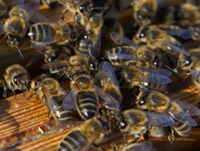
SICAMM was founded in 1995 at Flekkefjord, Norway by beekeepers and scientists from Austria, Denmark, Germany, Norway, Poland, Sweden, Switzerland and the United Kingdom, as an international association devoted to the protection of the European dark honeybee, Apis mellifera mellifera. Participation has since extended to most European countries. The main activity of SICAMM has been the organising of international conferences of which the 13th will take place in Finland next summer.
Impressum / Legal note

